Introduction to Japanese Cotton Cheesecake
Japanese Cotton Cheesecake, often celebrated for its cloud-like texture, has become a sensation among dessert lovers worldwide. If you’ve ever dreamed of indulging in a dessert that feels light and airy yet delivers rich flavor, this is the treat for you. Unlike traditional cheesecakes, which can be dense and heavy, this unique creation combines the fluffiness of a soufflé with the creamy essence of a cheesecake, making each bite a delightful experience.
Why Japanese Cotton Cheesecake is a Must-Try
What sets Japanese Cotton Cheesecake apart is its meticulous baking process that creates a soft, jiggly layer that wobbles temptingly—ideal for both aesthetic pleasure and taste. The combination of ingredients like cream cheese, fresh eggs, and just the right touch of vanilla harmonizes beautifully, delivering a subtle sweetness that pleases the palate.
Many chefs swear by this dish for special occasions; in fact, studies show that a well-made cheesecake can elevate a gathering's ambiance. The act of whipping egg whites into luscious peaks is a therapeutic process that yields gratifying results. As you embark on your culinary journey, you’ll find that making this dessert is not just about the end product, but also about savoring the creative process.
So, are you ready to impress your friends and family with this delightful dessert? Let's dive into the recipe!
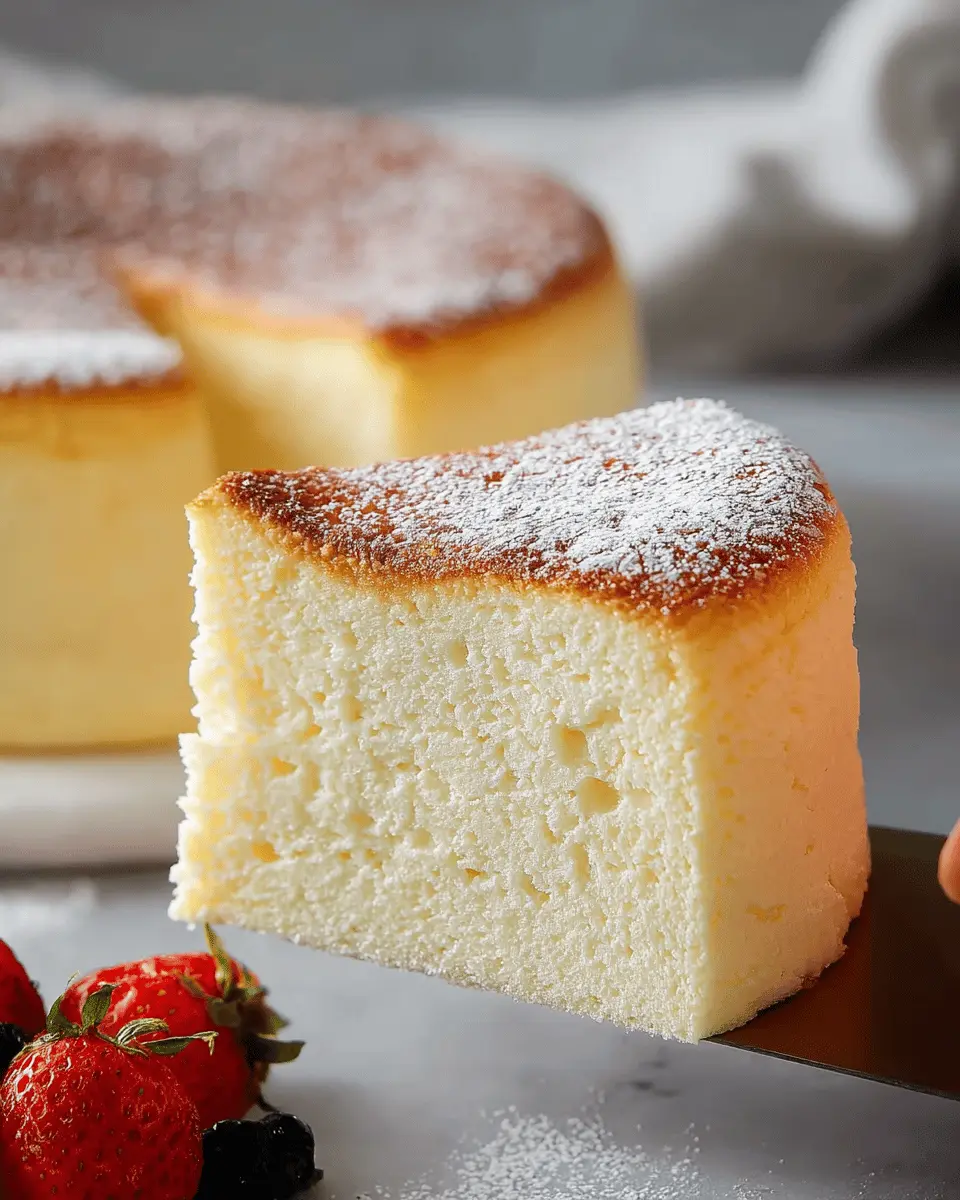
Ingredients for Japanese Cotton Cheesecake
Creating the perfect Japanese Cotton Cheesecake starts with carefully chosen ingredients. Here’s what you’ll need to whip up this airy delight:
- ¼ cup (30 g) cake flour – This is essential for that light and fluffy texture. You can find high-quality cake flour here.
- 2 tablespoons (20 g) cornstarch – This helps stabilize the cake and adds to its softness.
- ¾ cup (180 g) cream cheese – Opt for full-fat brick cream cheese for the best flavor.
- 2 tablespoons (30 g) unsalted butter – Make sure it's at room temperature for easy mixing.
- 3 ½ tablespoons (50 g) milk – Full-fat milk works best for a creamy consistency.
- 3 large egg yolks – Room temperature yolks contribute to better emulsification.
- ½ teaspoon (2 g) vanilla extract – This adds a lovely warmth and depth to the flavor.
- 3 large egg whites – They should also be at room temperature for optimal whisking.
- ⅓ cup (70 g) granulated sugar – This sweetens the cake without overpowering it. You can get quality granulated sugar here.
- ½ teaspoon (2 g) lemon juice – A touch of acidity balances the richness of the cake.
- Powdered sugar – This is optional, but a light dusting makes for a beautiful presentation.
With these ingredients gathered, you’re one step closer to enjoying a slice of Japanese Cotton Cheesecake that will impress your friends and family!
Preparing Japanese Cotton Cheesecake
Crafting a Japanese Cotton Cheesecake might seem daunting, but don't fret! With a bit of patience and the right guidance, you can create a fluffy, dreamy dessert that melts in your mouth. Here's a detailed, step-by-step approach to help you navigate the recipe effortlessly.
Gather Your Ingredients
Before diving into the baking process, ensure you have all your ingredients ready. For this delightful cheesecake, you will need:
- ¼ cup (30 g) cake flour
- 2 tablespoons (20 g) cornstarch
- ¾ cup (180 g) full-fat cream cheese
- 2 tablespoons (30 g) unsalted butter at room temperature
- 3½ tablespoons (50 g) full-fat milk
- 3 large egg yolks at room temperature
- ½ teaspoon (2 g) vanilla extract
- 3 large egg whites at room temperature
- ⅓ cup (70 g) granulated sugar
- ½ teaspoon (2 g) lemon juice
- Powdered sugar for garnish
Having everything prepared means fewer hiccups later in the process—and maybe more time to enjoy your creation!
Preheat Your Oven
Set the stage for your baking by preheating your oven to 300°F (150°C). This is a crucial step in ensuring your Japanese Cotton Cheesecake rises beautifully and gets that perfect texture.
Melt Cream Cheese and Butter
Utilize a double boiler for melting. Fill a saucepan halfway with water and bring it to a gentle boil. In a heat-safe bowl, combine the cream cheese, butter, and milk. Keep whisking until the mixture becomes smooth and reaches around 130°F (55°C). This step is essential for a creamy base!
Combine Egg Yolks and Vanilla
Once your cream cheese concoction has cooled a bit, whisk in the egg yolks and vanilla extract until well combined. This flavor blend will form the cornerstone of your cheesecake’s richness.
Sift and Mix Dry Ingredients
Next, grab your fine mesh sieve and sift in the cake flour and cornstarch. This ensures you have a smooth batter with no lumps. Mix gently until everything is incorporated and consistent.
Whip Egg Whites to Perfection
In a separate bowl, combine the egg whites with lemon juice. Using an electric mixer, beat them until they are white and frothy. Slowly add the granulated sugar in three increments, continuing to mix until you achieve medium-soft peaks. Your meringue should look glossy and form peaks that gently curl over.
Fold Meringue into Batter
With your meringue ready, fold one-third of it into the cream cheese batter. Be gentle to avoid deflating those precious air bubbles. Once mixed, gradually fold the remaining meringue, ensuring not to overmix—the fluffiness of your cheesecake relies on retaining that air!
Prepare the Baking Pan
Pour the cheesecake batter into your lined 6-inch round baking pan. To prevent large bubbles, lift the pan about five inches from the counter and let it drop gently. Next, nestle your pan into a larger baking tray and fill it with 1-2 cm of hot water. This water bath ensures even baking and adds moisture to the cheesecake, preventing cracks.
Bake the Cheesecake
Bake the cheesecake at 300°F (150°C) for 30 minutes. Then, lower the temperature to 230°F (110°C) for another 30 minutes. Finally, increase the heat slightly to 275°F (135°C) for an additional 13-15 minutes. If you see cracks, don’t panic—open the oven slightly to let some steam escape.
Let it Cool
Once baked, turn off the oven and let your cheesecake sit inside for about 15 minutes with the door cracked. Removing it from the water bath after this time minimizes temperature shock and protects your cheesecake from shrinking. Transfer it to a cooling rack, sift some powdered sugar on top, and enjoy your Japanese Cotton Cheesecake!
With these steps, you’re equipped to create a magnificent dessert sure to impress family and friends. Happy baking!
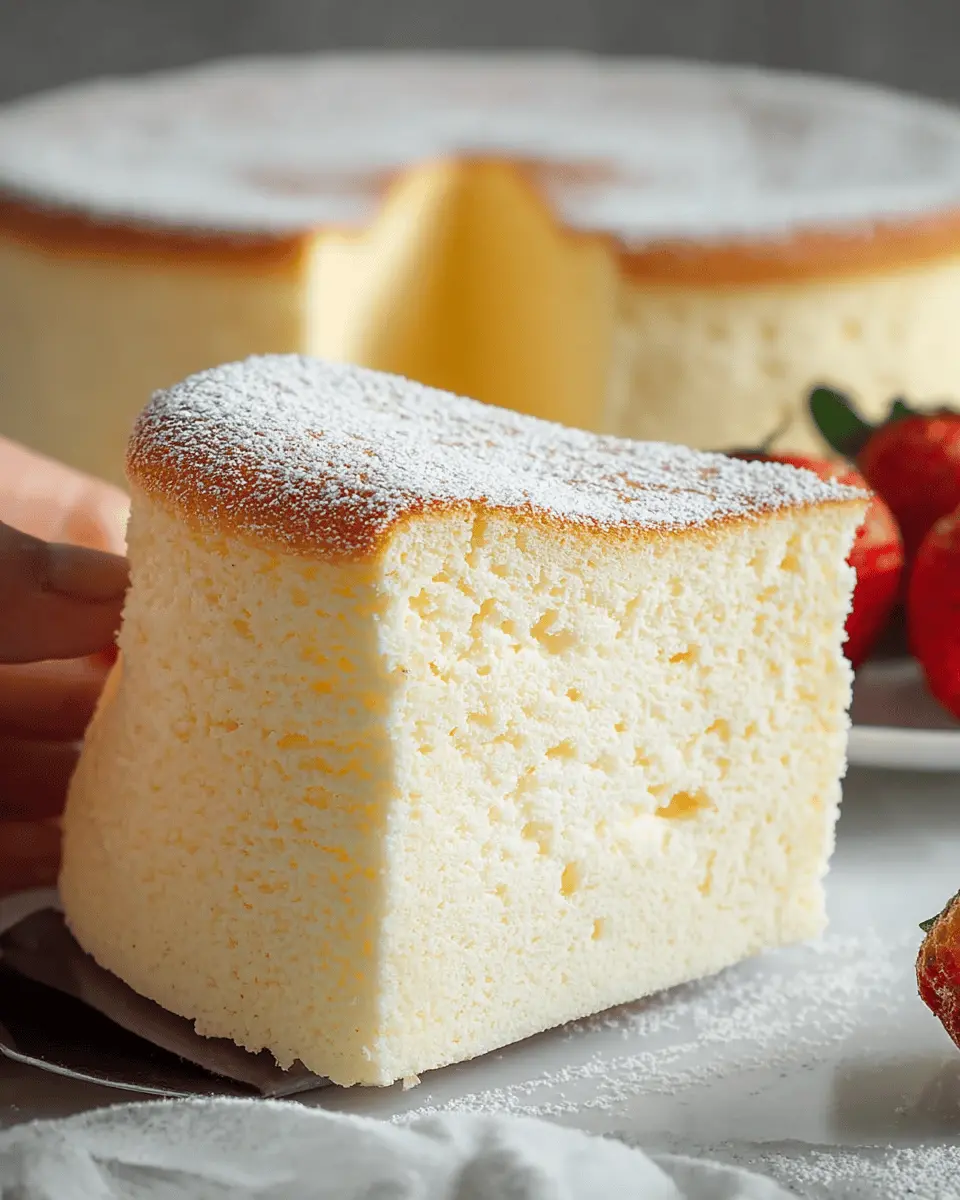
Variations on Japanese Cotton Cheesecake
Matcha Japanese Cotton Cheesecake
Elevate your Japanese Cotton Cheesecake by incorporating matcha, the vibrant green tea powder famous for its richness and earthy flavor. Just whisk in about 2 tablespoons of matcha into the cream cheese mixture during the initial steps. This not only gives the cheesecake a beautiful color but also infuses it with a delightful taste profile, perfect for matcha lovers.
Chocolate Japanese Cotton Cheesecake
For a deliciously rich twist, try adding chocolate! Melt about 4 ounces of dark chocolate and mix it in with the cream cheese and butter during the melting phase. This creates a luscious, chocolatey version of your Japanese Cotton Cheesecake that’s both airy and indulgent. Garnish with chocolate shavings for a stunning presentation that will impress your guests!
These variations are simple yet add a new dimension to your cheesecake experience. Explore more fun ideas and variations by checking out resources on Japanese desserts for more treasure troves of inspiration!
Baking Tips for Japanese Cotton Cheesecake
Creating the perfect Japanese Cotton Cheesecake can be a delightful adventure. Here are some friendly tips to elevate your baking game:
-
Use room temperature ingredients: Make sure your cream cheese, eggs, and butter are at room temperature. This ensures smoother mixing and a fluffier texture.
-
Whisk the meringue properly: Achieving medium-soft peaks in your egg whites is crucial. Look for a glossy finish where peaks softly curl over, indicating the right consistency.
-
Hot water bath magic: Baking in a hot water bath keeps the cheesecake moist and prevents cracking. It’s all about gentle cooking!
Consider checking out some expert resources on baking techniques, such as Serious Eats' meringue guide for additional insights. Happy baking!
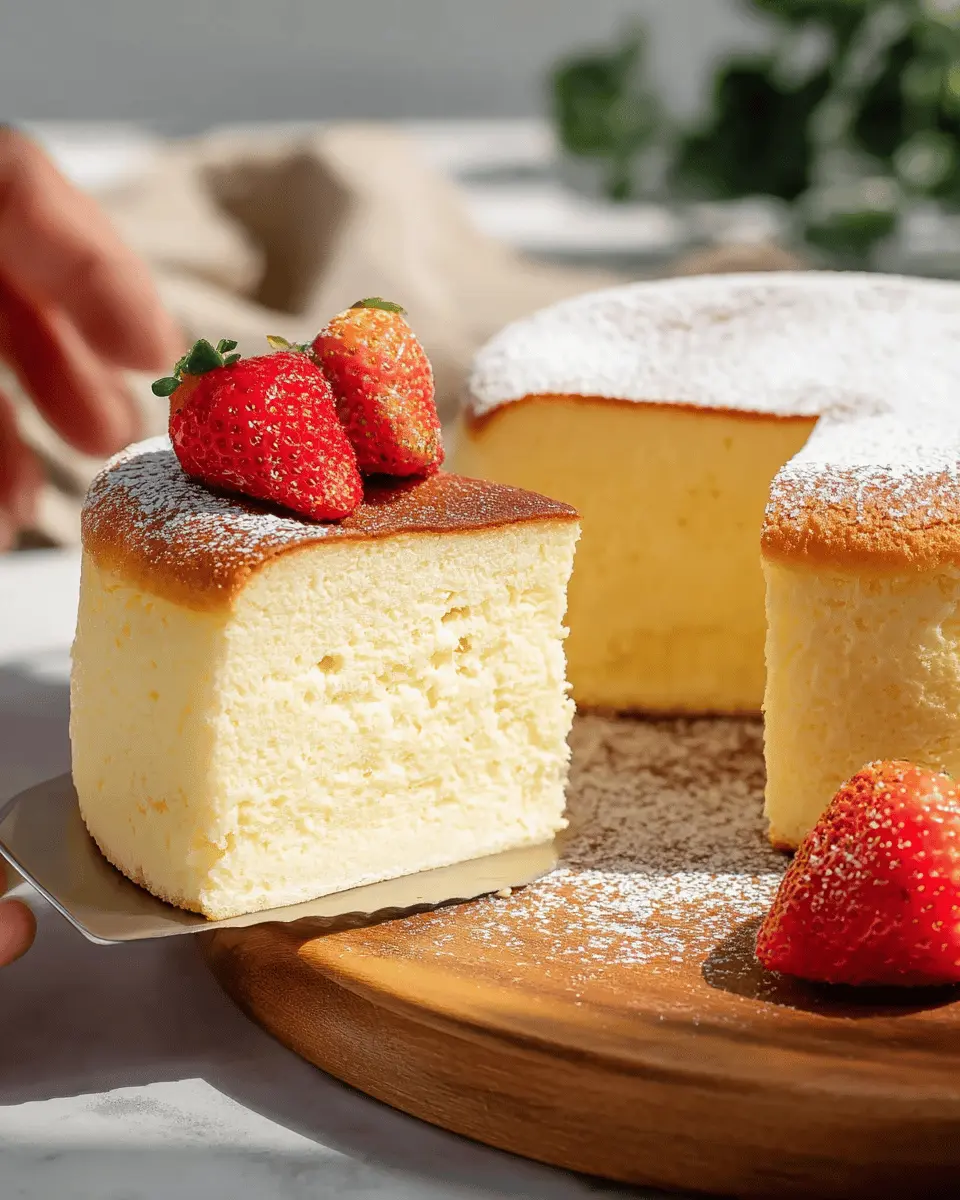
Serving Suggestions for Japanese Cotton Cheesecake
Indulging in a slice of Japanese Cotton Cheesecake is a treat in itself, but elevating the experience can make it even more delightful. Here are some friendly suggestions to savor this airy dessert:
- Fresh Berries: Serve with a mix of strawberries, blueberries, and raspberries. Their tartness beautifully balances the cheesecake’s sweetness.
- Chantilly Cream: A dollop of whipped cream adds a rich, velvety touch. You can also infuse it with vanilla or almond extract for an extra kick.
- Fruit Sauces: Drizzle with a homemade or store-bought berry sauce for a refreshing twist. Consider adding a splash of lemon juice to your sauce for brightness.
- Gelato or Sorbet: Pair with a scoop of green tea gelato or refreshing citrus sorbet to enhance the experience.
These serving options not only enhance the flavor of your Japanese Cotton Cheesecake but also bring a fresh, vibrant touch to your dessert plate! For more inspiration, check out this fantastic guide on dessert pairings that highlights various complementary flavors.
Time Breakdown for Japanese Cotton Cheesecake
When embarking on your delicious journey to create a Japanese Cotton Cheesecake, it's wise to keep track of your time. Here's a handy breakdown to help you plan your baking adventure!
Preparation Time
Getting ready for this fluffy delight takes about 30 minutes. This includes gathering your ingredients, preheating the oven, and mixing the batter.
Baking Time
For the perfect bake, allot around 1 hour and 15 minutes. This low-and-slow method ensures the cheesecake rises beautifully and sets correctly.
Total Time
In total, you're looking at approximately 1 hour and 45 minutes from start to finish. As you bake, perhaps consider sipping on a cozy beverage, like green tea, to elevate the experience.
With all this in mind, you’re all set to create that dreamy Japanese Cotton Cheesecake! Ready to impress your friends and family with a unique dessert? Let’s dive deeper into the recipe.
Nutritional Facts for Japanese Cotton Cheesecake
If you're indulging in a slice of Japanese Cotton Cheesecake, here's what you need to know about its nutritional content:
- Calories: Each serving contains about 224 calories, making it a delightful treat without too much guilt.
- Protein: This cheesecake offers a satisfying 12 grams of protein, thanks to the cream cheese and eggs, helping to keep you full longer.
- Sugar: With approximately 17 grams of sugar, the sweetness is balanced, perfect for satisfying those dessert cravings without overwhelming your taste buds.
For more information on the nutritional benefits of cream cheese and how it fits into a balanced diet, check out this resource from the USDA.
FAQs about Japanese Cotton Cheesecake
How do I store Japanese Cotton Cheesecake?
Storing your Japanese Cotton Cheesecake properly is essential to maintain its fluffy texture and flavor. Once cooled, cover the cheesecake with plastic wrap or store it in an airtight container. Keep it in the refrigerator, where it will last for up to three days. If you notice any moisture, you can place a paper towel inside the container to absorb excess humidity.
Can I make Japanese Cotton Cheesecake ahead of time?
Absolutely! Preparing your Japanese Cotton Cheesecake a day in advance can enhance its flavors. Just make sure to let it cool completely before storing it in the fridge. This allows it to firm up, making it easier to slice and serve later.
Why is it called “cotton” cheesecake?
The name "cotton cheesecake" comes from its incredibly light and airy texture, which resembles that of cotton. This delightful dessert achieves its signature fluffiness from whipped egg whites, giving it a heady rise that distinguishes it from traditional cheesecakes. It’s just as fun to eat as it is to make!
For more tips and tricks on baking, check out resources from Serious Eats or BBC Good Food.
Conclusion on Japanese Cotton Cheesecake
In conclusion, Japanese Cotton Cheesecake is a delightful blend of lightness and flavor that promises to impress anyone who takes a bite. Its airy texture and subtle sweetness make it perfect for any occasion—whether you're enjoying it solo or sharing with friends. Give it a try and savor the joy it brings!
For more inspiration, check out these great resources on baking techniques and cake decoration tips to elevate your dessert game!
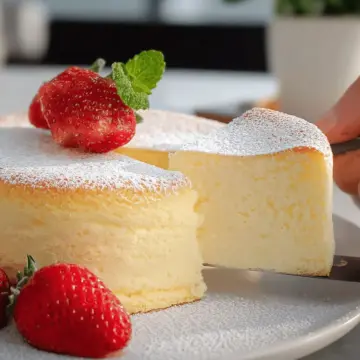
Japanese Cotton Cheesecake: The Best Soft and Fluffy Delight
Equipment
- Kitchen Scale
- Mixing Bowls
- Fine Mesh Sieve
- 6 Inch Baking Pan
- Electric Hand Mixer
Ingredients
- 0.25 cups cake flour (30 g)
- 2 tablespoons cornstarch (20 g)
- 0.75 cups cream cheese *full fat brick (180 g)*
- 2 tablespoons unsalted butter *room temperature (30 g)*
- 3.5 tablespoons milk *full fat (50 g)*
- 3 large egg yolks *room temperature*
- 0.5 teaspoons vanilla extract (2 g)
- 3 large egg whites *room temperature*
- 0.33 cups granulated sugar (70 g)
- 0.5 teaspoons lemon juice (2 g)
- powdered sugar *garnish*
Instructions
- Preheat your oven to 300°F and line the bottom and sides of your 6 inch round baking pan with parchment paper.
- Fill a small saucepan with water halfway and then bring it to a boil. In a mixing bowl that fits on top of the saucepan, add the cream cheese, butter and milk. Whisk until melted and fully combined and reaches about 130°F (55°C).
- Remove the cream cheese bowl from the heat and whisk in the egg yolks and vanilla until combined.
- Using a fine mesh sieve, sift in the cake flour and cornstarch. Whisk until smooth, then pour the batter through the fine mesh sieve to remove any lumps.
- In a large mixing bowl, add the egg whites and lemon juice. Beat the egg whites on high until white and frothy. Gradually add in ⅓ of the sugar in batches while mixing until medium soft peaks form.
- Mix ⅓ of the meringue into the egg batter until combined and smooth.
- Gently pour in the egg batter into the meringue and carefully fold until just combined.
- Pour the batter into the lined baking pan, dropping it from about 5 inches to pop large air bubbles. Place the pan into a larger deep baking tray filled with 1-2 cm of hot boiling water.
- Bake in the oven at 300°F (150°C) for 30 minutes, then lower to 230°F (110°C) for another 30 minutes. Increase to 275°F (135°C) for 13-15 minutes, keeping an eye on it.
- Once done, leave the cake in the oven for about 15 minutes with the door cracked. Remove the water bath and let it sit for another 15 minutes before cooling completely on a rack. Sift powdered sugar on top.

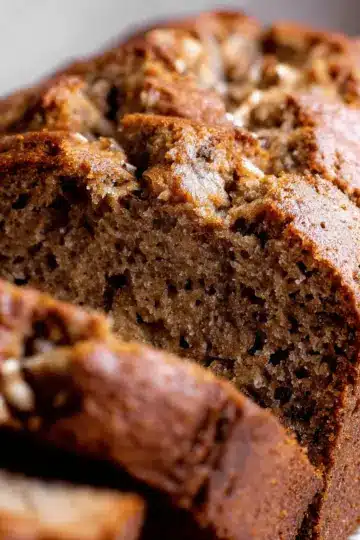

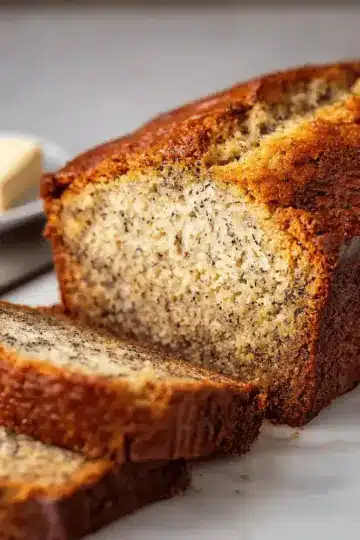

Leave a Reply